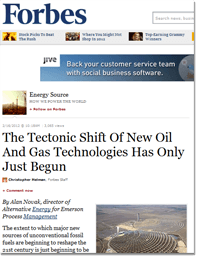 Our regular Friday posts here on the blog feature the Emerson experts in alternative energy. Alan Novak, director of the alternative energy industry team, has an article just published in Forbes magazine. The article, The Tectonic Shift Of New Oil And Gas Technologies Has Only Just Begun, pulls together many of the ideas shared here on the blog. I’ll highlight a couple of Alan’s thoughts from the article. He notes:
Our regular Friday posts here on the blog feature the Emerson experts in alternative energy. Alan Novak, director of the alternative energy industry team, has an article just published in Forbes magazine. The article, The Tectonic Shift Of New Oil And Gas Technologies Has Only Just Begun, pulls together many of the ideas shared here on the blog. I’ll highlight a couple of Alan’s thoughts from the article. He notes:
Remarkably – and almost abruptly – it now appears that the enormous challenge of satisfying a doubling in world energy demand by 2050 will probably be met. But it won’t be through renewable energy sources like solar and wind, although the role of these renewables will indeed rise. The lion’s share of the new energy production will come instead from shale oil and shale gas, deepwater drilling, oil sands and other unconventional sources of fossil fuel.
Alan highlights the role new technologies have played:
Behind these tectonic shifts are new technologies, some of which have quickly become well-known. They include hydraulic fracturing (“fracking”) and horizontal drilling, in the case of shale gas and shale oil, and steam assisted gravity drainage (SAGD), in the case of oil sands.
These technologies are:
…converting abundant coal to produce essential chemicals that previously were made only from petroleum. They’re re-engineering power plants that support major industrial facilities to use renewable fuels like wood waste and food byproducts. And they’re minimizing energy loss in production processes.
In posts such as Impact of Shale Gas on Coal Conversion Technologies and Biomass Fuel in Alternative Energy Production, Alan describes these technologies in greater depth.
Advancing technologies open up opportunities for cleaner fuels. He describes two conversion processes:
With GTL [gas to liquid] or CTL [coal to liquid] technology, we can also capture impurities like sulfur, nitrogen oxides, mercury, and soot in the production process – thereby creating a cleaner-burning fuel.
Driving some of these trends is the current economics among alternative sources of energy:
The combination of expensive oil and complex technologies have thus brought us into the age of “the fungible BTU,” in which we have unprecedented flexibility to choose among feedstocks.
Technologies that can control based on the energy or BTU content provide the opportunity for:
…a “hybrid” powerhouse that can seamlessly juggle among these renewable and conventional fuels. The results include reduced consumption of fossil fuels, reduced greenhouse emissions, and lower costs.
Give the article a read to see how technologies combined with vision and action are helping global energy supply respond to increasing demand, and do it with greater efficiency.




